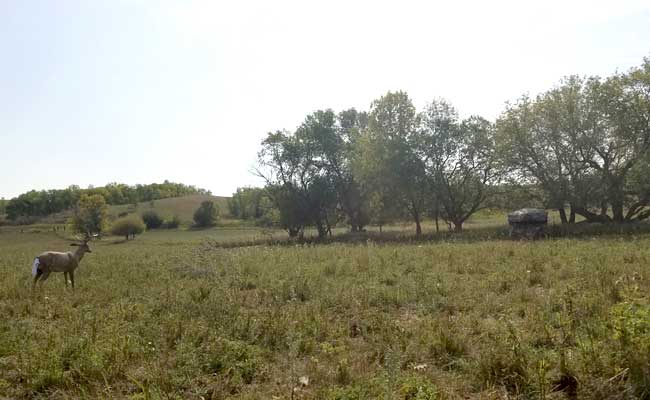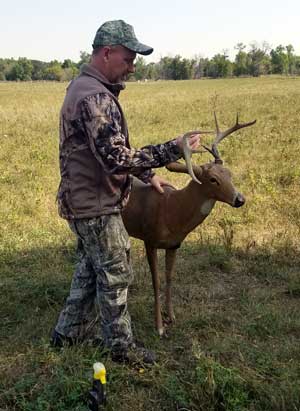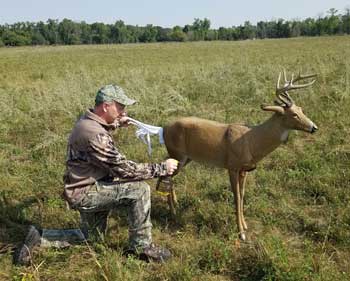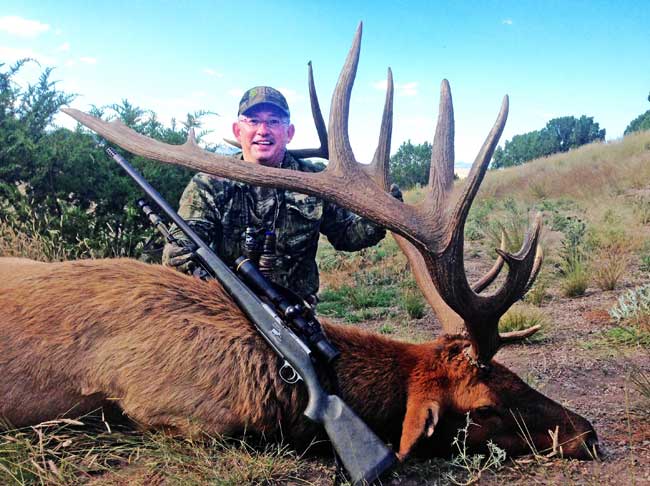D.J. Randolph | Mossy Oak ProStaff

Have you wondered if deer decoys would work for you or have you tried a decoy with bad results? You can make decoys work for you. I have been decoying whitetail for over 20 years and under the right circumstance it is very effective and makes for a very memorable hunt.
In this article I’ll share my experiences on why to use decoys, what kinds of decoys to use, what types of locations work best for decoying, using calls with decoys, scent control and some general tips from lessons that I have learned in the field.
Why use deer decoys?
Of course, the number one reason to use decoys is to kill a mature buck but another reason is that it is fun and exciting. Whitetail bucks are majestic animals. They usually come in to a set-up with their legs stiff and their back and neck hair standing up as they posture for the decoy. This gives you the opportunity to watch whitetail behavior that you don’t get to see that often and you get to watch under circumstances that you have set up. If you aren’t shooting, it’s a great time to have the camera in hand.
Buck decoy, doe decoy or both?
The question that I get all the time is whether to use a buck or doe decoy. You will notice throughout the article that I am usually using a buck or a buck and doe combination. In my experience, having a buck decoy in the set-up brings out the aggressive side of a buck. Most bucks in an area know one another. When a buck sees a stranger in his area he usually comes to investigate and establish a hierarchy. The only time that I would use a doe decoy by itself is if I am trying to kill a doe or an immature buck. I do this because younger bucks can be afraid of a buck decoy and some does tend to avoid a buck decoy.
What time of the year should I use decoys?
I use decoys throughout the season, if I feel hunting situation is right for it. Whitetail bucks tend to know the other bucks in their area. When you introduce a strange buck it brings out their aggressive side. Pre-rut through post-rut is without a doubt the most effective time to decoy, but I have also had great luck in the late season.
What style of deer decoy is best?
 There are two basic styles of decoys, full body or silhouette. I have had good luck with both styles. In the beginning, I even used my 3D target and had some luck with that.
There are two basic styles of decoys, full body or silhouette. I have had good luck with both styles. In the beginning, I even used my 3D target and had some luck with that.
Full Body - I prefer a full-body decoy because it is more realistic. The downside is that they are harder to store and transport. Full-body decoys are more expensive. They usually cost from $100 up.
Silhouette - I have had good luck with silhouette decoys. They are much easier to store and transport. The downsides are that they are not as realistic and they can be tough to use under windy conditions. Silhouette decoys usually cost from $50-$100.
In what locations should I use decoys and in what locations should I avoid using decoys?
Decoys work best in open areas where the deer can see the decoy and come to it on their own terms. Decoys do not work very well in heavy cover or in areas where the terrain hides the decoy from the deer’s view. In general, I think the deer should be able to see the decoy from at least 40 yards away. In my experience, deer can be startled by the decoy if they don’t see it until they are very close to it.
I use decoys in two specific situations:
- Use decoys in open areas where you see a lot of deer but they aren’t in shooting range. This is most commonly field edges whether it’s Conservation Reserve Program (CRP), crop or food plots. It can also be open woods where you can see many trails but need to get the deer to come to a certain crossing for a good shot.
- I have also used decoys to distract deer in areas where my choice of good stand or blind locations is limited. A deer focusing on the decoy is less likely to spot you when your location is less than ideal.
When you are setup at the field edge shooting into the field, you can see a lot of deer but it’s tough to get them into bow range. Setting up a decoy out in the field facing you is a great way to bring a buck into shooting range. If hunting from a ground blind, using a decoy also takes the focus off of your blind and puts it on the decoy. It can make an otherwise nervous buck curious or aggressive enough to make a mistake. This is also beneficial if you have a treestand along the field edge that doesn’t have the best cover.
Setting up in the field shooting towards the field edge is a tough setup to hunt, because deer can become very focused on your blind and too nervous to come within range. This is a set-up where I really like a buck and doe decoy. When a buck sees another buck that he doesn’t recognize trailing a doe in his area, his aggressive side usually takes over.
In my area, open woods are common in the river bottoms. There are multiple trails that you can see from the stand but they cover a wide area. In this situation, I like to set up a decoy at the edge of my shooting range. If possible, I like to have a barrier (brush pile, large tree or fence row, for example) behind the decoy. The barrier discourages the deer from trying to circle to the wrong side of the decoy.
Using calls with decoys
When decoying I will call fairly often. I usually use the same grunts or bleats that I would use when not using a decoy. This varies by time of the year. If I can see a buck and he either hasn’t seen the decoy or is not interested, I will become more aggressive in my calling. I will use an aggressive grunt until I know that he has seen the decoy. If it is during any stage of the rut and I can see a buck that I would like to shoot, I will use a snort-wheeze call. A snort-wheeze call is one buck basically telling another buck to back off. Most mature bucks find it hard to back down from this challenge.
Decoys actually ad realism to calling deer. When coming to a call a buck feels much more confident when he can actually see a deer to come to.
Scent elimination and attractant scents
 When using decoys, scent is critical. A mature buck and particularly an old mature doe will not tolerate any human scent on the decoy. I use a lot of scent-eliminating spray. I use gloves and spray my hands before I setup and I then spray the decoy once the setup is complete. On private property, I leave my decoy on site if possible. This eliminates transporting it each time and really reduces the amount of human scent that it comes into contact with. I will either store the decoy in my blind or stash it in the brush and cover it with some branches and debris.
When using decoys, scent is critical. A mature buck and particularly an old mature doe will not tolerate any human scent on the decoy. I use a lot of scent-eliminating spray. I use gloves and spray my hands before I setup and I then spray the decoy once the setup is complete. On private property, I leave my decoy on site if possible. This eliminates transporting it each time and really reduces the amount of human scent that it comes into contact with. I will either store the decoy in my blind or stash it in the brush and cover it with some branches and debris.
I never use attractant scents on the decoy itself. I use a piece of lightweight white cloth that is shredded a little so it moves in the wind. Any scent that I use I put on this cloth and attach to the tail of the decoy. I store the cloth in a good Ziploc bag and always take with me. Except during the rut, I use a basic deer scent. During all stages of the rut, I will use a dominant buck scent on a buck decoy or an estrus doe scent on a doe decoy.
Guidelines to remember when setting up your decoy or decoys:
- The decoys need to be scent free. I use a lot of scent-eliminating product on my decoys.
- You should always set up with the wind blowing from the decoy towards you. Most deer will try to circle downwind of the decoy. This is ideal because it puts the deer between you and the decoy, but with the deer’s attention focused on the decoy.
- I set up my decoy at the edge of my effective shooting range. You want enough room between you and the decoy for the deer to circle without getting behind you. Sometimes deer will walk right up to the decoy so I always make sure that the decoy is within my effective shooting range.
- If I am using a buck decoy, I set up with the decoy quartering towards me. Most bucks approach the decoy from head on so this positions the buck quartering away from me.
- If I am using a doe, I position the decoy broadside to me. This way whether a buck approaches from behind or in front of the decoy there is still a shot opportunity.
- If using both a buck and doe decoy I set up with both quartering towards me with the buck a few yards behind the doe.
- Except during the rut, I use a basic deer scent. During all stages of the rut I will use a dominant buck scent on a buck decoy or an estrus doe scent on a doe decoy.
In 2010, I had been hunting a large field that borders a very thick wooded property line. Hunting the property line was not an option, so I set up a blind 30 yards out in the field in a corner where deer frequently traveled. It was late in the rut, so I decided to set up both buck and doe silhouettes along the field edge, facing my blind.
I had a few nice bucks on trail camera on this property and had waited for the perfect wind. As shooting light was fading I saw a really nice buck coming along the field edge about 200 yards south of my setup. He was moving slowly so I had plenty of time to get prepared and even get the video camera rolling. It looked like he would come right to the set up but at about 125 yards he went into the trees.
I thought my hunt was over but a few minutes later he emerged from the trees about 60 yards from the set up and there was no doubt that he was coming in. He was walking stiff legged and his back and neck hair were standing on end. I was ranging him the whole way in. When he got to 35 yards he hesitated and I decided to take the shot. As I released he started to move so my shot ended up at the back of the rib cage. I knew it was a lethal shot, but I wasn’t sure how fast he would go down so I decided to wait till morning to recover him. At daybreak the next morning, I only had to trail him about 80 yards. I am very certain that those decoys made all the difference with this buck.
Decoying whitetail bucks is effective and it’s a very exciting way to hunt. It isn’t foolproof but if you use these tips, I am sure you will have some memorable experiences.






























